CAT 2020 DILR - Slot 2 Past Year Questions
CAT 2020 | DILR Set 1
DIRECTIONS for the question: Read the information given below and answer the question that follows.
-
- Two adjacent beads along the same row or column are always of different colours.
- There is at least one Green bead between any two Blue beads along the same row or column.
- There is at least one Blue and at least one Green bead between any two Red beads along the same row or column.
1. The total number of possible configurations using beads of only two colors is:
If we have to use 2 colors, then those two colors have to be Blue and Green only, because if
red color is used, then there has to be at least one green and one blue between any two beads.
There are two possible configurations if exactly 2 colors are used. Diagrams are shown below:
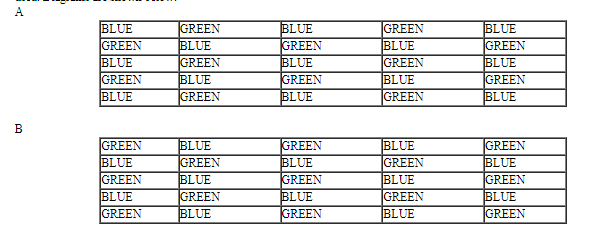
2. What is the maximum possible number of Red beads that can appear in any configuration?
Maximum number of red beads can appear only when we minimize Blue and Green colored
beads.
 So we can see that there are 9 Red colored beads in the above arrangement.
So we can see that there are 9 Red colored beads in the above arrangement.
3. What is the minimum number of Blue beads in any configuration?
Minimum number of blue beads can appear only when we maximize Red and Green colored
beads.
The arrangement is as given below:
So we can see that there are 6 Blue colored beads in the above arrangement.

4. Two Red beads have been placed in ‘second row, third column’ and ‘third row, second column’. How many more Red beads can be placed so as tomaximise the number of Red beads used in the configuration?
We will make the arrangement as given in the question:
Now we can see that there will be maximum 6 red colored beads which satisfy the given
arrangement.
CAT 2020 | DILR Set 2
DIRECTIONS for the question: Read the information given below and answer the question that follows.
The Humanities department of a college is planning to organize eight seminars, one for each of the eight doctoral students – A, B, C, D, E, F, G and H. Four of them are from Economics, three from Sociology and one from Anthropology department. Each student is guided by one among P, Q, R, S and T. Two students are guided by each of P, R and T, while one student is guided by each of Q and S. Each student is guided by a guide belonging to their department.
Each seminar is to be scheduled in one of four consecutive 30-minute slots starting at 9:00am, 9:30 am, 10:00 am and 10:30 am on the same day. More than one seminars can be scheduled in a slot, provided the guide is free. Only three rooms are available and hence at the most three seminars can be Scheduled in a slot. Students who are guided by the same guide must be scheduled in consecutive slots.
The following additional facts are also known.
- Seminars by students from Economics are scheduled in each of the four slots.
- A’s is the only seminar that is scheduled at 10:00 am. A is guided by R.
- F is an Anthropology student whose seminar is scheduled at 10:30 am.
- The seminar of a Sociology student is scheduled at 9:00 am.
- B and G are both Sociology students, whose seminars are scheduled in the same slot. The seminar of an Economics student, who is guided by T, is also scheduled in the same slot.
- P, who is guiding both B and C, has students scheduled in the first two slots.
- A and G are scheduled in two consecutive slots.
5. Which one of the following statements is true?
- Three seminars are scheduled in the first slot.
- Two seminars are scheduled in the first slot.
- Only one seminar is scheduled in the second slot.
- Three seminars are scheduled in the last slot.
From 1, Economics is at scheduled at each slot
From 2, Only A is scheduled at 10 so it has to be Economics and guided by R
From 5, 6 and 7 B,G and C are having seminar on Sociology. B and C are guided by P and
having seminar in first two slots so C will be at 9, B and G will be at 9:30 and 1 student from
economics guided by T will be also be at 9:30. R cannot be at 9 because Students who are
guided by the same guide must be scheduled in consecutive slots.
From 3, F is at 10:30, so at 9:30, 3 students are there and at 9 am, C and 1 more student having
economics would be there, at 10 am only 1 student would be there. At 10:30 2 students one
having economics and other having anthropology would be there.
From the information given we can draw following table
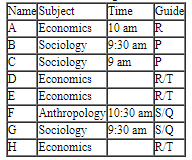 From the above information only two would be in 1st slot
From the above information only two would be in 1st slot
6. Who all are NOT guiding any Economics students?
- P, Q and S
- P, R and S
- Q, R and S
- P, Q and R
From 1, Economics is at scheduled at each slot
From 2, Only A is scheduled at 10 so it has to be Economics and guided by R
From 5, 6 and 7 B,G and C are having seminar on Sociology. B and C are guided by P and
having seminar in first two slots so C will be at 9, B and G will be at 9:30 and 1 student from
economics guided by T will be also be at 9:30. R cannot be at 9 because Students who are
guided by the same guide must be scheduled in consecutive slots.
From 3, F is at 10:30, so at 9:30, 3 students are there and at 9 am, C and 1 more student having
economics would be there, at 10 am only 1 student would be there. At 10:30 2 students one
having economics and other having anthropology would be there.
From the information given we can draw following table
 Economics are guided by R and T. So ans. is Option 1
Economics are guided by R and T. So ans. is Option 1
7. Which of the following statements is necessarily true?
- B is scheduled in the first slot.
- H is an Economics student.
- Q is guiding G
- S is guiding F.
From 1, Economics is at scheduled at each slot
From 2, Only A is scheduled at 10 so it has to be Economics and guided by R
From 5, 6 and 7 B,G and C are having seminar on Sociology. B and C are guided by P and
having seminar in first two slots so C will be at 9, B and G will be at 9:30 and 1 student from
economics guided by T will be also be at 9:30. R cannot be at 9 because Students who are
guided by the same guide must be scheduled in consecutive slots.
From 3, F is at 10:30, so at 9:30, 3 students are there and at 9 am, C and 1 more student having
economics would be there, at 10 am only 1 student would be there. At 10:30 2 students one
having economics and other having anthropology would be there.
From the information given we can draw following table
 From the above information H is an Economics student.
From the above information H is an Economics student.
8. If D is scheduled in a slot later than Q’s, then which of the following two statement(s) is (are) true?
(i)E and H are guided by T.
(ii) G is guided by Q.
- Only (i)
- Both (i) and (ii)
- Only (ii)
- Neither (i) nor (ii)
From 1, Economics is at scheduled at each slot
From 2, Only A is scheduled at 10 so it has to be Economics and guided by R
From 5, 6 and 7 B,G and C are having seminar on Sociology. B and C are guided by P and
having seminar in first two slots so C will be at 9, B and G will be at 9:30 and 1 student from
economics guided by T will be also be at 9:30. R cannot be at 9 because Students who are
guided by the same guide must be scheduled in consecutive slots.
From 3, F is at 10:30, so at 9:30, 3 students are there and at 9 am, C and 1 more student having
economics would be there, at 10 am only 1 student would be there. At 10:30 2 students one
having economics and other having anthropology would be there.
From the information given we can draw following table
 If D is scheduled later than Q then, Q will be at 9:30 and He will guide G and S will guide F.
R will guide D at 10:30. E and H will be guided by T. So ans is option 2
If D is scheduled later than Q then, Q will be at 9:30 and He will guide G and S will guide F.
R will guide D at 10:30. E and H will be guided by T. So ans is option 2
9. If E and Q are both scheduled in the same slot, then which of the following statements BEST describes the relationship between D, H, and T?
- At least one of D and H is guided by T.
- Neither D nor H is guided by T.
- Both D and H are guided by T.
- Exactly one of D and H is guided by T.
From 1, Economics is at scheduled at each slot
From 2, Only A is scheduled at 10 so it has to be Economics and guided by R
From 5, 6 and 7 B,G and C are having seminar on Sociology. B and C are guided by P and
having seminar in first two slots so C will be at 9, B and G will be at 9:30 and 1 student from
economics guided by T will be also be at 9:30. R cannot be at 9 because Students who are
guided by the same guide must be scheduled in consecutive slots.
From 3, F is at 10:30, so at 9:30, 3 students are there and at 9 am, C and 1 more student having
economics would be there, at 10 am only 1 student would be there. At 10:30 2 students one
having economics and other having anthropology would be there.
From the information given we can draw following table
 If E and Q are in same slot then it will be 9:30 or at 10:30
If E will be guided by R then D and H will be guided by T, and if E will be guided by T then
one of D and H will be guided by T
So At least one of D and H is guided by T
So ans. will be 1st option
If E and Q are in same slot then it will be 9:30 or at 10:30
If E will be guided by R then D and H will be guided by T, and if E will be guided by T then
one of D and H will be guided by T
So At least one of D and H is guided by T
So ans. will be 1st option
10. If D is scheduled in the slot immediately before Q’s, then which of the following is NOT necessarily true?
- D is guided by T.
- G is guided by Q.
- F is guided by S.
- E is guided by R.
From 1, Economics is at scheduled at each slot
From 2, Only A is scheduled at 10 so it has to be Economics and guided by R
From 5, 6 and 7 B,G and C are having seminar on Sociology. B and C are guided by P and
having seminar in first two slots so C will be at 9, B and G will be at 9:30 and 1 student from economics guided by T will be also be at 9:30. R cannot be at 9 because Students who are
guided by the same guide must be scheduled in consecutive slots.
From 3, F is at 10:30, so at 9:30, 3 students are there and at 9 am, C and 1 more student having
economics would be there, at 10 am only 1 student would be there. At 10:30 2 students one
having economics and other having anthropology would be there.
From the information given we can draw following table
 If D is immediately before Q then Q is at 9:30 and D is at 9 that means F if guided by S at
10:30, G is guided by Q, D and E can be guided by R/T
So ans is option 4
If D is immediately before Q then Q is at 9:30 and D is at 9 that means F if guided by S at
10:30, G is guided by Q, D and E can be guided by R/T
So ans is option 4
Correct Answer 5
Option B
Correct Answer 6
Option A
Correct Answer 7
Option B
Correct Answer 8
Option B
Correct Answer 9
Option A
Correct Answer 10
Option D
CAT 2020 | DILR Set 3
DIRECTIONS for the question: Go through the graph and the information given below and answer the question that follows.
In an election several candidates contested for a constituency. In any constituency, the winning candidate was the one who polled the highest number of votes, the first runner up was the one who polled the second highest number of votes, the second runner up was the one who polled the third highest number of votes, and so on. There were no ties (in terms of number of votes polled by the candidates) in any of the constituencies in this election.
In an electoral system, a security deposit is the sum of money that a candidate is required to pay to the election commission before he or she is permitted to contest. Only the defeated candidates (i.e., one who is not the winning candidate) who fail to secure more than one sixth of the valid votes polled in the constituency, lose their security deposits.
The following table provides some Incomplete information about votes polled in four constituencies: A,B, C and D, in this election.
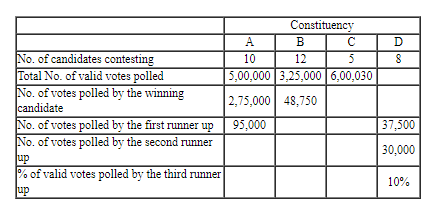
The following additional facts are known:
- The first runner up polled 10,000 more votes than the second runner up in constituency A.
- None of the candidates who contested in constituency C lost their security deposit. The difference in votes polled by any pair of candidates in this constituency was at least 10,000.
- The winning candidate in constituency D polled 5% of valid votes more than that of the first runner up. All the candidates who lost their security deposits while contesting for this constituency, put together, polled 35% of the valid votes.
11. What is the percentage of votes polled in total by all the candidates who lost their security deposits while contesting for constituency A?
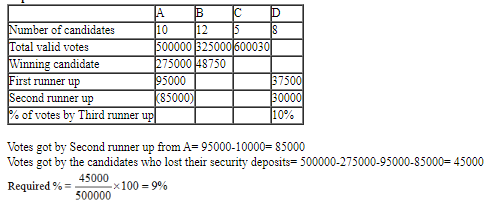
12. How many candidates who contested in constituency B lost their security deposit?
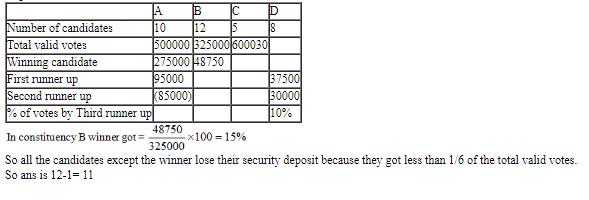
13. What BEST can be concluded about the number of votes polled by the winning candidate in constituency C?
- Less than 2,00,010
- 1,40,010
- Between 1,40,005 and 1,40,010
- 1,40,006
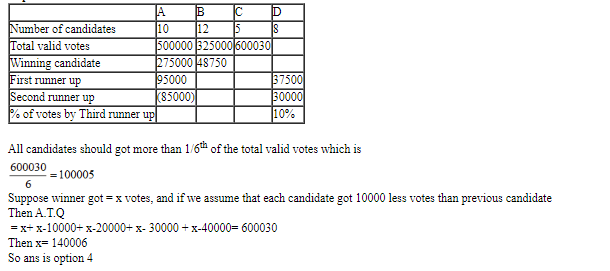
14. What was the number of valid votes polled in constituency D?
- 1,75,000
- 1,50,000
- 62,500
- 1,25,000
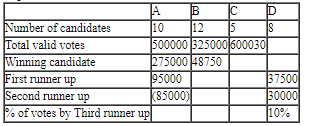 Let the valid votes in constituency D= x
1st runner up got = 37500
Winner got 37500+.05x
2nd runner up got 30000 votes and the remaining candidates loose their security so
A.T.Q
37500+ .05x+ 37500+30000= 0.65x
So x= 175000
So ans is 1st option
Let the valid votes in constituency D= x
1st runner up got = 37500
Winner got 37500+.05x
2nd runner up got 30000 votes and the remaining candidates loose their security so
A.T.Q
37500+ .05x+ 37500+30000= 0.65x
So x= 175000
So ans is 1st option
15. The winning margin of a constituency is defined as the difference of votes polled by the winner and that of the first runner up. Which of the following CANNOT be the list of constituencies, in increasing order of winning margin?
- B, C, D, A
- D, B, C, A
- B, D, C, A
- D, C, B, A
 Winning margin in constituency D = .05 x 175000= 8750
Winning margin of C is atleast 10000 that means margin of C is greater than D
So option 1 is wrong.
Winning margin in constituency D = .05 x 175000= 8750
Winning margin of C is atleast 10000 that means margin of C is greater than D
So option 1 is wrong.
16. For all the four constituencies taken together, what was the approximate number of votes polled by all the candidates who lost their security deposit expressed as a percentage of the total valid votes from these four constituencies?
- 23.91%
- 23.54%
- 32.00%
- 38.25%
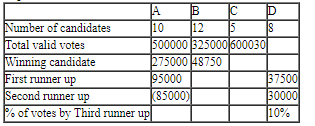 Total votes = 500000 + 325000 + 600030 + 175000= 1600030
In A ( 500000-275000-95000-85000) = 45000 votes were polled to the candidates who lost
their security
In B, All candidates except the winner lost their security which is equal to 325000- 48750=
276250
In C, no one lost the security
In D, 35% of 175000= 61250 votes are polled to the candidates who lost their security
Total votes polled to the candidates who lost their security = 45000+276250+61250= 382500
So answer is option 1
Total votes = 500000 + 325000 + 600030 + 175000= 1600030
In A ( 500000-275000-95000-85000) = 45000 votes were polled to the candidates who lost
their security
In B, All candidates except the winner lost their security which is equal to 325000- 48750=
276250
In C, no one lost the security
In D, 35% of 175000= 61250 votes are polled to the candidates who lost their security
Total votes polled to the candidates who lost their security = 45000+276250+61250= 382500
So answer is option 1
Correct Answer 11
9
Correct Answer 12
11
Correct Answer 13
Option D
Correct Answer 14
Option A
Correct Answer 15
Option A
Correct Answer 16
Option A
CAT 2020 | DILR Set 4
DIRECTIONS for the question: Read the information given below and answer the question that follows.
A chain of departmental stores has outlets in Delhi, Mumbai, Bengaluru and Kolkata. The sales are categorized by its three departments – ‘Apparel’, ‘Electronics’, and ‘HomeDecor’. An Accountant has been asked to prepare a summary of the 2018 and 2019 sales amounts for an internal report. He has collated partial information and prepared the following table.

The following additional information is known.
- The sales amounts in the Apparel departments were the same for Delhi and Kolkata in2018.
- The sales amounts in the Apparel departments were the same for Mumbai and Bengaluru in 2018. This sales amount matched the sales amount in the Apparel department for Delhi in2019.
- The sales amounts in the Home Décor departments were the same for Mumbai and Kolkata in 2018.
- The sum of the sales amounts of four Electronics departments increased by the same amount as the sum of the sales amounts of four Apparel departments from 2018 to 2019.
- The total sales amounts of the four Home Décor departments increased by Rs 70 Crores from 2018 to 2019.
- The sales amounts in the Home Décor departments of Delhi and Bengaluru each increased by Rs 20 Crores from 2018 to 2019.
- The sales amounts in the Apparel departments of Delhi and Bengaluru each increased by the same amount in 2019 from 2018. The sales amounts in the Apparel departments of Mumbai and Kolkata also each increased by the same amount in 2019 from 2018.
- The sales amounts in the Apparel departments of Delhi, Kolkata and Bengaluru in 2019 followed an Arithmetic Progression.
17. In HomeDecor departments of which cities were the sales amounts the highest in 2018 and 2019, respectively?
- Mumbai and Mumbai
- Delhi and Delhi
- Bengaluru and Delhi
- Mumbai and Delhi
We have the following incomplete table which can be filled with different letters as per the
condition given.
 In last point it is given that y, 54 and b are A. P. ⇒ bb + y = 108 ----(1)
The total of electronics dept. In 2018 = 330cr
Total of electronics dept. in 2019 = 370cr
Incase are in sales in 2019 as compare to 2018 is 40 cr
As per the point 4, we have
(y + c + b + 54) - (x + y + y + x) = 40
⇒ b + c + 54 - y - 2x = 40
⇒ 2x + y - b - c = 14 ---(2)
From 7, we have y - x = b - y
⇒ b = 2y - x -----(3)
& c - y = 54 - x
⇒ c = 54 + y - x ---(4)
Using (3) & (4) in (2) we get 2x + y - 2y + x - 54 - y + x = 14
⇒ 4x - 2y = 68
⇒ 2x - y = 34 ---(5)
Using (3) in (1), we get, 3y - x = 108 --(6)
Solve (5) & 6, to get y = 50, x = 42
∴ (3) ⇒ b = 58
(4) ⇒ c = 62
Total sale of Home décor increased by Rs 70 cr. Using point 6, we can say that sale of Home
décor in Delhi in 2018 is Rs 80 cr & in Bengaluru in 2018 is Rs 60 Cr.
Now 72 - a + 54 - a = 30
⇒ 2a = 96 ⇒ a = 48
Hence the final table is as below
In last point it is given that y, 54 and b are A. P. ⇒ bb + y = 108 ----(1)
The total of electronics dept. In 2018 = 330cr
Total of electronics dept. in 2019 = 370cr
Incase are in sales in 2019 as compare to 2018 is 40 cr
As per the point 4, we have
(y + c + b + 54) - (x + y + y + x) = 40
⇒ b + c + 54 - y - 2x = 40
⇒ 2x + y - b - c = 14 ---(2)
From 7, we have y - x = b - y
⇒ b = 2y - x -----(3)
& c - y = 54 - x
⇒ c = 54 + y - x ---(4)
Using (3) & (4) in (2) we get 2x + y - 2y + x - 54 - y + x = 14
⇒ 4x - 2y = 68
⇒ 2x - y = 34 ---(5)
Using (3) in (1), we get, 3y - x = 108 --(6)
Solve (5) & 6, to get y = 50, x = 42
∴ (3) ⇒ b = 58
(4) ⇒ c = 62
Total sale of Home décor increased by Rs 70 cr. Using point 6, we can say that sale of Home
décor in Delhi in 2018 is Rs 80 cr & in Bengaluru in 2018 is Rs 60 Cr.
Now 72 - a + 54 - a = 30
⇒ 2a = 96 ⇒ a = 48
Hence the final table is as below
 In Home décor, Delhi has maximum sales in 2018 & 2019.
In Home décor, Delhi has maximum sales in 2018 & 2019.
18. What was the increase in sales amount, in Crore Rupees, in the Apparel department of Mumbai from 2018 to 2019?
- 10
- 5
- 8
- 12
We have the following incomplete table which can be filled with different letters as per the
condition given.
 In last point it is given that y, 54 and b are A. P. ⇒ bb + y = 108 ----(1)
The total of electronics dept. In 2018 = 330cr
Total of electronics dept. in 2019 = 370cr
Incase are in sales in 2019 as compare to 2018 is 40 cr
As per the point 4, we have
(y + c + b + 54) - (x + y + y + x) = 40
⇒ b + c + 54 - y - 2x = 40
⇒ 2x + y - b - c = 14 ---(2)
From 7, we have y - x = b - y
⇒ b = 2y - x -----(3)
& c - y = 54 - x
⇒ c = 54 + y - x ---(4)
Using (3) & (4) in (2) we get 2x + y - 2y + x - 54 - y + x = 14
⇒ 4x - 2y = 68
⇒ 2x - y = 34 ---(5)
Using (3) in (1), we get, 3y - x = 108 --(6)
Solve (5) & 6, to get y = 50, x = 42
∴ (3) ⇒ b = 58
(4) ⇒ c = 62
Total sale of Home décor increased by Rs 70 cr. Using point 6, we can say that sale of Home
décor in Delhi in 2018 is Rs 80 cr & in Bengaluru in 2018 is Rs 60 Cr.
Now 72 - a + 54 - a = 30
⇒ 2a = 96 ⇒ a = 48
Hence the final table is as below
In last point it is given that y, 54 and b are A. P. ⇒ bb + y = 108 ----(1)
The total of electronics dept. In 2018 = 330cr
Total of electronics dept. in 2019 = 370cr
Incase are in sales in 2019 as compare to 2018 is 40 cr
As per the point 4, we have
(y + c + b + 54) - (x + y + y + x) = 40
⇒ b + c + 54 - y - 2x = 40
⇒ 2x + y - b - c = 14 ---(2)
From 7, we have y - x = b - y
⇒ b = 2y - x -----(3)
& c - y = 54 - x
⇒ c = 54 + y - x ---(4)
Using (3) & (4) in (2) we get 2x + y - 2y + x - 54 - y + x = 14
⇒ 4x - 2y = 68
⇒ 2x - y = 34 ---(5)
Using (3) in (1), we get, 3y - x = 108 --(6)
Solve (5) & 6, to get y = 50, x = 42
∴ (3) ⇒ b = 58
(4) ⇒ c = 62
Total sale of Home décor increased by Rs 70 cr. Using point 6, we can say that sale of Home
décor in Delhi in 2018 is Rs 80 cr & in Bengaluru in 2018 is Rs 60 Cr.
Now 72 - a + 54 - a = 30
⇒ 2a = 96 ⇒ a = 48
Hence the final table is as below
 In Mumbai, the sales of Apparel dept. Increased by Rs. 12 cr.
In Mumbai, the sales of Apparel dept. Increased by Rs. 12 cr.
19. Among all the 12 departments (i.e., the 3 departments in each of the 4 cities), what was the maximum percentage increase in sales amount from 2018 to 2019?
- 75
- 50
- 28
- 25
We have the following incomplete table which can be filled with different letters as per the
condition given.
 In last point it is given that y, 54 and b are A. P. ⇒ bb + y = 108 ----(1)
The total of electronics dept. In 2018 = 330cr
Total of electronics dept. in 2019 = 370cr
Incase are in sales in 2019 as compare to 2018 is 40 cr
As per the point 4, we have
(y + c + b + 54) - (x + y + y + x) = 40
⇒ b + c + 54 - y - 2x = 40
⇒ 2x + y - b - c = 14 ---(2)
From 7, we have y - x = b - y
⇒ b = 2y - x -----(3)
& c - y = 54 - x
⇒ c = 54 + y - x ---(4)
Using (3) & (4) in (2) we get 2x + y - 2y + x - 54 - y + x = 14
⇒ 4x - 2y = 68
⇒ 2x - y = 34 ---(5)
Using (3) in (1), we get, 3y - x = 108 --(6)
Solve (5) & 6, to get y = 50, x = 42
∴ (3) ⇒ b = 58
(4) ⇒ c = 62
Total sale of Home décor increased by Rs 70 cr. Using point 6, we can say that sale of Home
décor in Delhi in 2018 is Rs 80 cr & in Bengaluru in 2018 is Rs 60 Cr.
Now 72 - a + 54 - a = 30
⇒ 2a = 96 ⇒ a = 48
Hence the final table is as below
In last point it is given that y, 54 and b are A. P. ⇒ bb + y = 108 ----(1)
The total of electronics dept. In 2018 = 330cr
Total of electronics dept. in 2019 = 370cr
Incase are in sales in 2019 as compare to 2018 is 40 cr
As per the point 4, we have
(y + c + b + 54) - (x + y + y + x) = 40
⇒ b + c + 54 - y - 2x = 40
⇒ 2x + y - b - c = 14 ---(2)
From 7, we have y - x = b - y
⇒ b = 2y - x -----(3)
& c - y = 54 - x
⇒ c = 54 + y - x ---(4)
Using (3) & (4) in (2) we get 2x + y - 2y + x - 54 - y + x = 14
⇒ 4x - 2y = 68
⇒ 2x - y = 34 ---(5)
Using (3) in (1), we get, 3y - x = 108 --(6)
Solve (5) & 6, to get y = 50, x = 42
∴ (3) ⇒ b = 58
(4) ⇒ c = 62
Total sale of Home décor increased by Rs 70 cr. Using point 6, we can say that sale of Home
décor in Delhi in 2018 is Rs 80 cr & in Bengaluru in 2018 is Rs 60 Cr.
Now 72 - a + 54 - a = 30
⇒ 2a = 96 ⇒ a = 48
Hence the final table is as below
 The max % increase is 50% for Mumbai in Home décor dept.
The max % increase is 50% for Mumbai in Home décor dept.
20. What was the total sales amount, in Crore Rupees, in 2019 for the chain of departmental stores?
- 600
- 150
- 750
- 900
We have the following incomplete table which can be filled with different letters as per the
condition given.
 In last point it is given that y, 54 and b are A. P. ⇒ bb + y = 108 ----(1)
The total of electronics dept. In 2018 = 330cr
Total of electronics dept. in 2019 = 370cr
Incase are in sales in 2019 as compare to 2018 is 40 cr
As per the point 4, we have
(y + c + b + 54) - (x + y + y + x) = 40
⇒ b + c + 54 - y - 2x = 40
⇒ 2x + y - b - c = 14 ---(2)
From 7, we have y - x = b - y
⇒ b = 2y - x -----(3)
& c - y = 54 - x
⇒ c = 54 + y - x ---(4)
Using (3) & (4) in (2) we get 2x + y - 2y + x - 54 - y + x = 14
⇒ 4x - 2y = 68
⇒ 2x - y = 34 ---(5)
Using (3) in (1), we get, 3y - x = 108 --(6)
Solve (5) & 6, to get y = 50, x = 42
∴ (3) ⇒ b = 58
(4) ⇒ c = 62
Total sale of Home décor increased by Rs 70 cr. Using point 6, we can say that sale of Home
décor in Delhi in 2018 is Rs 80 cr & in Bengaluru in 2018 is Rs 60 Cr.
Now 72 - a + 54 - a = 30
⇒ 2a = 96 ⇒ a = 48
Hence the final table is as below
In last point it is given that y, 54 and b are A. P. ⇒ bb + y = 108 ----(1)
The total of electronics dept. In 2018 = 330cr
Total of electronics dept. in 2019 = 370cr
Incase are in sales in 2019 as compare to 2018 is 40 cr
As per the point 4, we have
(y + c + b + 54) - (x + y + y + x) = 40
⇒ b + c + 54 - y - 2x = 40
⇒ 2x + y - b - c = 14 ---(2)
From 7, we have y - x = b - y
⇒ b = 2y - x -----(3)
& c - y = 54 - x
⇒ c = 54 + y - x ---(4)
Using (3) & (4) in (2) we get 2x + y - 2y + x - 54 - y + x = 14
⇒ 4x - 2y = 68
⇒ 2x - y = 34 ---(5)
Using (3) in (1), we get, 3y - x = 108 --(6)
Solve (5) & 6, to get y = 50, x = 42
∴ (3) ⇒ b = 58
(4) ⇒ c = 62
Total sale of Home décor increased by Rs 70 cr. Using point 6, we can say that sale of Home
décor in Delhi in 2018 is Rs 80 cr & in Bengaluru in 2018 is Rs 60 Cr.
Now 72 - a + 54 - a = 30
⇒ 2a = 96 ⇒ a = 48
Hence the final table is as below
 The total sales of all dept. In 2019 is Rs. 900 crore
The total sales of all dept. In 2019 is Rs. 900 crore
Correct Answer 17
Option B
Correct Answer 18
Option D
Correct Answer 19
Option B
Correct Answer 20
Option D
CAT 2020 | DILR Set 5
DIRECTIONS for the question: Read the information given below and answer the question that follows.
Six people U, V, W, X, Y, and Z, are standing at different intersections. No two people are standing at the same intersection.
21. Initially cars numbered 1, 2, 3, and 4 arrive among which 1 and 4 are SUVs while 2 and3 are compact cars. Car 1 then leaves, followed by the arrivals of car 5 (a compact car) and car 6 (an SUV). Car 4 then leaves. Then car 7 (an SUV) and car 8 (a compact car)arrive. At this moment, which among the following numbered car is parked next to car3?
- 8
- 5
- 7
- 6
The initial cars are 1, 2, 3, 4, when can 1 leaves, we have the arrangement V V 2 3 4 Now car 5 (a compact car) and car 6 (an SUV) came. So arrangement is 5 V 2 3 4 6 Now care 4 left, we have the arrangement 5 V 2 3 V V 6 Now car 7 (an S U V) and car 8 ( a compact car) arrived, so final arrangement is 5, 8, 2, 3, 7, 6. Hence car number 7 is parked next to car 3.
22. Suppose eight cars have arrived, of which two have left. Also suppose that car 4 is a compact and car 7 is an SUV. Which of the following is a POSSIBLE current configuration of the parking lot?
- 8, 2, 3, V, 5, 6, 7
- 8, 2, 3, V, 6, 5, 7
- V, 2, 3, 7, 5, 6, 8
- 8, 2, 3, V, 5, 7, 6
As per the options, car 1 & car 4 left as Car 8 is the last car to arrive, so it should be either at 1st position or the last position. So option 3 is wrong. In option 2, the position of car 4 is vacant. If car 5 arrived after car 4 left, then it should have been next to car 3. If car 4 left after the car 5 arrived, then car 5 should be next to V. in any case, car 5 cannot be after car 6. Hence option 2 is wrong. In option 4, it is clear that car 4 left after car 5 arrived. So car next to car 5 should be car 6. Hence it is wrong. Only option 1 is true where car 4 left after car 5 arrived.
23. Suppose the sequence at some point of time is 4, 5, 6, V, 3. Which of the following is NOT necessarily true?
- Car 3 is an SUV
- Car 5 is a compact
- Car 4 is a compact
- Car 1 is an SUV
Total cars arrived here are 6 and car 3 is placed in the end. It is possible it cars 1 & 2 are S UV, then we have the arrangement 1 2 3 Now cars 1 & 2 left, then the arrangement is V V V V 3 After that the cars 4, 5, 6 arrived in order so that the final arrangement is. 4 5 6 V 3 Hence cars 4 & 5 are compact & car 1 is an S U V. but we cannot say about car 3, whether it is an S U V or a compact car.
24. Suppose that car 4 is not the first car to leave and that the sequence at a time between the arrival of the car 7 and car 8 is V, 7, 3, 6, 5. Then which of the following statements MUST be false?
- Car 4 is an SUV
- Car 2 is a compact
- Car 6 is a compact
- Car 7 is a compact
The original order is 1 2 3 4 5. Now car 6 is at the place of car 4 and car 4 is not the first one to leave. So either car 1 & car 2 will leave first. If we assume that the first car left is car 1, them as car 2 is also leaving, so car 7 will take the first position. So first position cannot be empty. Hence car 2 is the one which left at the first place and after it car 4 left. So we have following possibilities. 1 V 3 V 5 or 1 V 3 V V 5 Car 2 is not an S U V because in that case, car 6 will be next to car 1. Also car 6 is not compact otherwise, it will be again next to car 1. So car 6 is an S U V and we have the order 1 V 3 6 5 Now car 7 came which is compact and order is 1 7 3 6 5. After that the car 1 left to give the final order as V 7 3 6 5
Correct Answer 21
Option C
Correct Answer 22
Option A
Correct Answer 23
Option A
Correct Answer 24
Option C
















